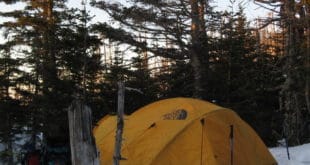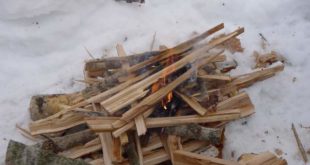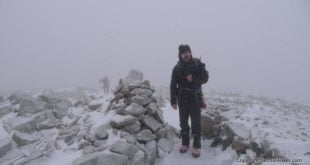If you’re properly prepared, camping in winter is a lot of fun. But pitching a tent in winter, particularly on snow, requires some different gear and technique. The first thing you need to focus on is site selection: make sure that you …
Read More »Winter Hiking
Dead Men in Winter
One very important skill you need in winter is how to stake out a tent or shelter when the ground is frozen or covered with snow. You can do this with skis, ice axes, and hiking poles, but people also use a …
Read More »Winter Backpacking Above-Treeline Gear List
Last weekend I went on a difficult 2 night backpacking trip that involved a 19 mile traverse of the Presidential Range in New Hampshire, including 15 miles of fully-exposed, above-treeline hiking. We had great weather, but you never know what is going …
Read More »The Wisdom of Hiking Groups: Reflections on Solo Winter Hiking in the Northern Presidential Range
The big story last week was the accidental death of a solo hiker, Kate Matrosova, who died from exposure between Mt Madison and Mt Adams in New Hampshire’s Northern Presidential Mountain Range. A so-called “expert hiker”, she attempted to traverse Mt Madison, Adams, Jefferson, …
Read More »Winter Fire Building Practice – Twice Makes Right
I headed back into the winter woods to practice building a winter fire, a survival skill that I want to master in case I ever need an emergency fire. (see Winter Survival Fire Lighting Skills – Why Don’t We Teach Them? and Winter …
Read More »Torso Deep Snow Caves
I'm still at it this winter, building practice snow shelters and caves in my front yard. This time, I built a simple snow cave featured in the Revised Edition of Allen & Mike's Really Cool Backcountry Ski Book, which is the illustrated …
Read More »Cross Country Skiing: A Different Way to Experience the Trail
Cross-country skiing is a popular sport in New Hampshire’s White Mountains and one that complements the excellent winter hiking and snowshoeing in the region. It also provides access to winter views, such as the one of Mt Crawford here from the banks …
Read More »MYOG Reflectix Insulated Stove Base for Winter Camping
Reflectix Home Insulation is great stuff for making homemade MYOG backpacking projects. Consisting of bubble wrap sandwiched between two layers of tin foil, it’s relatively inexpensive, easy to find at home improvement stores, highly malleable, and thermally efficient. I’ve also been using Reflectix …
Read More »Winter Fire Building Practice Trip
This trip was motivated by an accident report I read about in Appalachia Magazine where the victim couldn’t get a fire started in winter conditions. The Appalachia Accident Editor recommended that winter hikers practice winter firelighting skills which is a topic that’s left out …
Read More »Multi-Purpose Items as Snow Anchors
Question You need to set up a shelter fast, but don’t have the time for snow anchors to set. What pieces of multi-purpose gear can you use to set up a winter tent, shaped tarp, or flat tarp? Answer If I’m up …
Read More »Winter Backpacking Gear List
I believe in creating a new gear list for every trip I take that takes into consideration the environmental conditions (weather, terrain, water, navigation, sunlight, etc) I’m likely to encounter. There was a time when I had one static gear list, but …
Read More »Winter Survival Fire Lighting Skills – Why Don’t We Teach Them?
The latest issue of the Appalachia Journal arrived last night and I immediately turned to the Accidents Section to read the analysis of this autumn’s accident reports. Established in 1876, Appalachian is America’s longest running journal of mountaineering and conservation. Published quarterly, …
Read More »Serius Innovation Extreme Neoprene Face Mask Review
When hiking above treeline in winter, it is very important that you have several forms of protection to protect your face and head from cold and wind. The fact of the matter is that you can freeze your face off unless you …
Read More »Winter Backpacking Food
One of the best things about winter backpacking and mountaineering trips is the food. You can eat just about anything and never feel guilty about it, including these Ritter Sport Bars which pack over 630 calories each! Seriously though, winter nutrition is …
Read More » SectionHiker.com Backpacking Gear Reviews and FAQs
SectionHiker.com Backpacking Gear Reviews and FAQs 












